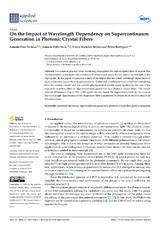Mostrar el registro sencillo del ítem
On the impact of wavelength dependency on supercontinuum generation in photonic crystal fibers
| dc.contributor.author | Díaz Soriano, Antonio Manuel | |
| dc.contributor.author | Ortiz Mora, Antonio | |
| dc.contributor.author | Martínez-Muñoz, David | |
| dc.contributor.author | Rodríguez, Pedro | |
| dc.date.accessioned | 2024-02-13T10:44:37Z | |
| dc.date.available | 2024-02-13T10:44:37Z | |
| dc.date.issued | 2024 | |
| dc.identifier.issn | 2076-3417 | |
| dc.identifier.uri | http://hdl.handle.net/10396/27452 | |
| dc.description.abstract | It is common practice when simulating propagation through an optical fiber to assume that its characteristic parameters are constant and determined solely by the central wavelength of the input pulse. In this paper, we propose a study of the impact that the actual wavelength dependence of these parameters has on the propagation results. To this end, simulations were carried out considering both the constant model and the wavelength-dependent model, applying them to the case of the especially sensitive effect of supercontinuous generation in a photonic crystal fiber. The results showed differences of up to 20% of the spectrum and, hence, the importance of taking into account the wavelength dependence of the dispersion fiber parameters to obtain more-realistic results in the simulations. | es_ES |
| dc.format.mimetype | application/pdf | es_ES |
| dc.language.iso | eng | es_ES |
| dc.publisher | MDPI | es_ES |
| dc.rights | https://creativecommons.org/licenses/by/4.0/ | es_ES |
| dc.source | Appl. Sci., 14(4), 1429 (2024) | es_ES |
| dc.subject | Numerical simulation | es_ES |
| dc.subject | Supercontinuum generation | es_ES |
| dc.subject | Photonic crystal fiber | es_ES |
| dc.subject | Pulse propagation | es_ES |
| dc.title | On the impact of wavelength dependency on supercontinuum generation in photonic crystal fibers | es_ES |
| dc.type | info:eu-repo/semantics/article | es_ES |
| dc.relation.publisherversion | https://doi.org/10.3390/app14041429 | es_ES |
| dc.rights.accessRights | info:eu-repo/semantics/openAccess | es_ES |

